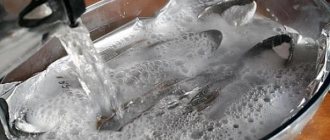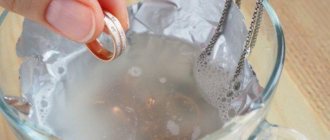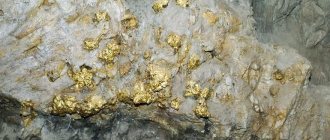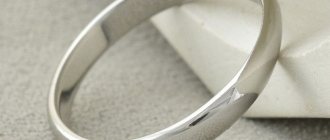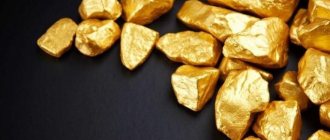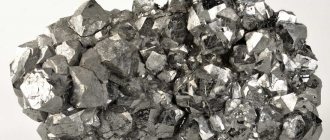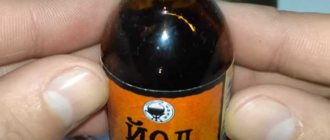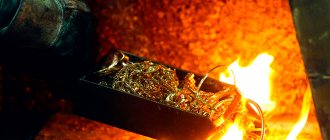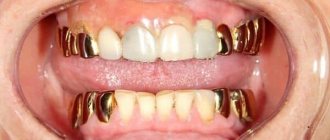Hello my readers! As a child, I thought that if you boiled my mother's ring in a saucepan, it would melt. I really wanted to see how metal melted, and I managed to conduct a dozen experiments before my mother found out that she was growing up a metallurgist. Neither experiment was successful because the melting point of gold is 1064.4 °C (degrees Celsius), and water boils at only 100 °C.
Now I have grown up and I know that everything is not so simple. But melting gold at home is still possible, although it requires more than just a saucepan and gas.
STRUCTURE
Crystal structure of gold
Crystallizes in the cubic system, in the form of octahedra, rhombic dodecahedrons, cubes and more complex crystals; They are often distorted, strongly elongated, forming “wires”, “hairs”, or flattened parallel to the octahedron face. Native gold, especially low-grade gold, is characterized by a variety of growth forms; it is usually in the form of skeletal crystals, dendrites, thread-like and twisted-filamentary crystals. Streak-like and irregular lump-like, “hooked” discharges are widespread; Their surfaces often contain imprints of crystals of other minerals, the aggregates of which included accumulations of native gold. Etching reveals the crystalline granular structure of the gold particles.
What is the heating device made of?
If it is not possible to get professional equipment, you can melt gold using a gasoline burner. Before you start making it, you need to acquire the following:
- Airbrush spray. An air injector or garden equipment that sprays chemicals is quite suitable for this purpose.
- A jar. It is important that it has an airtight lid.
- Automotive air pump. A machine compressor is also suitable.
- With a hose.
- Sealant.
PROPERTIES
Gold bars and nuggets
Gold is a very heavy metal: the density of pure gold is 19.32 g/cm³ (a ball of pure gold with a diameter of 46.237 mm has a mass of 1 kg). Diamagnetic, that is, the magnetic field in gold weakens. Among metals, it ranks seventh in density after osmium, iridium, rhenium, platinum, neptunium and plutonium. Tungsten has a density comparable to gold (19.25). The high density of gold makes it easier to extract, which is why even simple technological processes - for example, washing at sluices - can provide a high degree of gold recovery from the washed rock. Gold is a very soft metal: hardness on the Mohs scale is ~2.5, on the Brinell scale 220-250 MPa (comparable to the hardness of a fingernail). Gold is also highly ductile: it can be forged into sheets up to ~0.1 µm (100 nm) thick (gold leaf); With such a thickness, gold is translucent and in reflected light has a yellow color, in transmitted light it is colored bluish-greenish, complementary to yellow. Gold can be drawn into wire with a linear density of up to 2 mg/m. The melting point of gold is 1064.18 °C (1337.33 K), boils at 2856 °C (3129 K). The density of liquid gold is less than solid gold and is 17 g/cm3 at the melting point. Liquid gold is quite volatile and actively evaporates long before its boiling point.
What will you need for work?
Before you melt gold at home, you need to have the following:
- Crucible. If for pure gold the melting point is 1064 degrees, then for alloys containing copper, more heating will be required. Therefore, there is a need for a container that can withstand high temperatures. If you couldn’t get a crucible, you can use a potato. It is enough to cut a hole in the center of a raw root vegetable for gold.
- With tongs. Preference should be given to products made from heat-resistant materials.
- A flux used to purify gold. It is presented as a mixture containing borax and sodium carbonate. According to experts, at least two pinches of flux are required to clean one ounce of precious metal. You can also cope with this task using bicarbonate and baking soda.
- A furnace for melting metal. Electric furnaces for working with precious metals are presented to consumers in specialized stores. Judging by numerous reviews, home craftsmen use microwaves for this purpose. However, not every microwave oven will do. It is imperative that its power is not lower than 1200 W, and the magnetron is located in the side or rear part. According to experts, it is not recommended to further heat food in a stove that contained molten gold. If there is only one microwave in the house, and the master is not ready to sacrifice it, then we can recommend that he purchase a gasoline burner.
RESERVES AND PRODUCTION
Golden Nugget
The gold content in the earth's crust is very low - 4.3·10-10% by weight (0.5-5 mg/t), but deposits and areas sharply enriched in the metal are very numerous. Gold is also found in water. One liter of both sea and river water contains less than 5·10−9 grams of Au, which approximately corresponds to 5 kilograms of gold in 1 cubic kilometer of water. Gold deposits occur predominantly in areas of granitoid development; a small number of them are associated with basic and ultrabasic rocks. To obtain gold, its basic physical and chemical properties are used: its presence in nature in a native state, the ability to react with only a few substances (mercury, cyanide). With the development of modern technologies, chemical methods are becoming more popular. In 1947, American physicists Ingram, Hess and Haydn conducted an experiment to measure the effective cross section for the absorption of neutrons by mercury nuclei. As a side effect of the experiment, about 35 micrograms of gold was obtained. Thus, the centuries-old dream of alchemists was realized - the transmutation of mercury into gold. However, such gold production has no economic significance, since it costs many times more than extracting gold from the poorest ores.
How to clean castings
After the borax has served its purpose and cleansed the molten gold of excess compounds, you will have to rid the ingot of the remnants of the borax itself. For final cleaning you will need:
- hydrochloric acid - 20 ml;
- nitric acid - 10 ml;
- distilled water - 0.5 l;
- fireproof flask;
- electric stove.
The casting must be boiled in an acid solution for 5 minutes and rinsed with clean water. This part of the experiment is best carried out outdoors, for example in a summer cottage: acid fumes are toxic.
ORIGIN
Gold products
Native gold is the main form of gold found in nature. It concentrates in hydrothermal deposits forming gold ores, unevenly distributed in fractured vein quartz and in sulfides - pyrite, arsenopyrite, pyrrhotite, etc. In essentially sulfide ores, native gold is finely dispersed. During the oxidation of ores on the earth's surface, fine native gold is partially dissolved and redeposited; in some cases it enriches the upper parts of ore bodies. The processes of their destruction lead to the release of particles of native gold and their accumulation in placers; moving with water flows together with other plastic material, the particles become rounded, rounded, deformed, and partially recrystallized; As a result of electrochemical corrosion, a thin shell of high-fine gold is formed on them, which leads to a general increase in the standard of native gold in placers.
Main advantage
If you think that gold is valued for its beauty, you are a little mistaken. It turns out that the gold metal is valued for its unique flexibility. When gold is exposed to high temperatures, it takes on small forms, and at low temperatures, metal particles form a massive vein. The resulting veins can be seen with the naked eye.
Jeweler's work
Plus, gold is resistant to corrosion. There are cases where gold jewelry lay in the ground for decades, and after removal it remained in its original form, without changing color or shape. The precious yellow metal is resistant to chemicals and belongs to the noble category.
APPLICATION
Golden coins
In terms of its chemical resistance and mechanical strength, gold is inferior to most platinum group metals, but is irreplaceable as a material for electrical contacts. Therefore, in microelectronics, gold conductors and gold electroplating of contact surfaces, connectors, and printed circuit boards are used very widely. Gold is used as a target in nuclear research, as a coating for mirrors operating in the far infrared range, and as a special shell in a neutron bomb. A thin layer of gold (20 nm) on the inner surface of window and stained glass glass significantly reduces unwanted heat losses in winter, and in summer it protects the interior of buildings and vehicles from heating by infrared rays. Gold solders wet various metal surfaces very well and are used in metal soldering. Thin gaskets made from soft gold alloys are used in ultra-high vacuum technology. The traditional and largest consumer of gold is the jewelry industry. Jewelry is made not from pure gold, but from its alloys with other metals, which are significantly superior to gold in mechanical strength and durability. Currently, Au-Ag-Cu alloys are used for this, which may contain additives of zinc, nickel, cobalt, and palladium. The corrosion resistance of such alloys is determined mainly by their gold content, and the color shades and mechanical properties are determined by the ratio of silver and copper. Dentistry consumes significant amounts of gold: crowns and dentures are made from alloys of gold with silver, copper, nickel, platinum, and zinc. Such alloys combine corrosion resistance with high mechanical properties. Gold compounds are included in some medications used to treat a number of diseases (tuberculosis, rheumatoid arthritis, etc.). The radioactive isotope 198Au (half-life 2.967 days) is used in the treatment of malignant tumors in radiotherapy.
Gold – Au
| Molecular weight | 196.97 g/mol |
| origin of name | Proto-Slavic “*zolto” (“gold”) is related to Lit. geltonas "yellow", Latvian. zelts "gold". |
| IMA status | valid, first described before 1959 (before IMA) |
Hallmark on 585 hallmark
The authenticity of the yellow metal must always be confirmed by a stamp indicating its purity. In Russia, this procedure is mandatory and controlled by the state. The hallmark allows the buyer to be confident in the quality and authenticity of the precious metal.
There are three branding options:
- Laser;
- Electroerosive;
- Mechanical.
The modern laser method allows you to place a mark with a high degree of readability. But the image can quickly be erased, especially if the branding site is constantly in contact with another surface. The mechanical method is still recognized as the most durable.
An example of a mark on a product and its explanation.
The mark itself consists of three parts: a letter (the hallmark code), a drawing (a woman’s head with a kokoshnik, looking to the left), and the number “585” (the hallmark itself). In addition to these symbols, a piece of jewelry may have another mark – the manufacturer’s name.
Products that are imported into Russia are also tested. In Italy and the USA there is no state standard and all responsibility for the authenticity of jewelry lies only with the manufacturer. The mark on foreign products usually consists of the symbols “14 K” (14 carats, corresponding to the domestic 585 standard) and letters indicating the manufacturer.
PHYSICAL PROPERTIES
| Mineral color | rich yellow, fading to white-yellow with a predominance of silver |
| Stroke color | brilliant yellow |
| Transparency | opaque |
| Shine | metal |
| Cleavage | No |
| Hardness (Mohs scale) | 2,5-3 |
| Strength | malleable |
| Kink | jagged |
| Density (measured) | 15 – 19.3 g/cm3 |
| Radioactivity (GRapi) | 0 |
| Magnetism | diamagnetic |
Level of international reserves
International reserves of the world's countries in 2006
| States with the largest international reserves. | $1953 (March 2009) | |
| 2 | Japan | $1042.34 (August 2009) |
| — | Eurozone | $531 (February 2009) |
| 3 | Russia | $413 (July 2009) |
| 4 | Republic of China | $305 (April 2009) |
| 5 | India | $256 (May 2009) |
| 6 | The Republic of Korea | $212 (April 2009) |
| 7 | Brazil | $203 (March 2009) |
| 8 | Hong Kong | $186 (March 2009) |
| 9 | Singapore | $166 (March 2009) |
| 10 | Germany | $144 (February 2009) |
These ten countries contain more than 50 percent of the world's total international reserves.
A little history
Because gold could be found almost anywhere in the world, it became an essential element in almost all human cultures.
Starting with Ancient Egypt, where decorative gold objects dating back over 5,000 years have been found. Advertising - Continued below
The beauty of gold was associated by ancient people with immortality and the wealth of the gods, so jewelry and decorative elements were made from it. Gold was also one of the first currencies to replace traditional barter exchange.
Children's gold bracelet. Egypt. Approximately 2650 BC Photo: www.metmuseum.org
The very first gold coins were minted in the kingdom of Lydia in 550 BC, and since then this metal has remained the main element of the monetary system. Even after modern paper money was adopted, currencies remained linked through the Gold Standard, a system introduced in the 1870s that fixed the value of these currencies in a certain amount of gold.
What stones go best with gold in jewelry?
18K Gold Carved Ruby Ring by ARTISAN
Gold is so versatile that it goes well with all stones. An exception is aquamarine on white gold - on it it is almost invisible and is lost from attention, but some will like this option. Also, some consider it unacceptable to combine bright red stones (for example, garnet or ruby) with yellow gold. But, again, this is a matter of taste.
